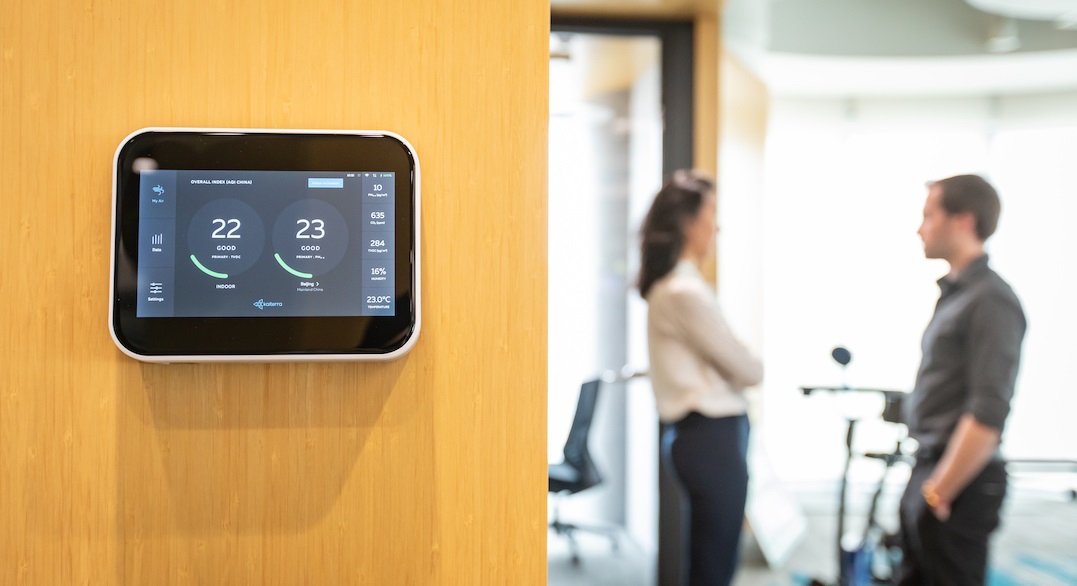Newsletter
While the COVID-19 pandemic may have drawn mainstream attention to the health and safety aspects of buildings and interiors, other important aspects are now rising to the forefront of the discussion. When it comes to the modern workplace, optimizing workplace wellness and building comfort is crucial for ensuring employees are productive and satisfied. Read on to discover how monitoring certain IAQ parameters can help you to achieve this.
How IAQ Parameters Relate to Workplace Wellbeing and Workplace Experience
Workplace experience (WX) describes the conscious experience of employees in a given workplace, while workplace wellness refers to both the ideal state of that experience, and the range of initiatives that can be implemented to improve it, such as mindfulness classes or mandatory lunches. Despite the recent emergence of these terms, they are swiftly gaining prominence as newer generations of employees prove increasingly concerned with job related stress and work-life balance.
Awareness of IAQ parameters is a central tenet for achieving workplace wellness and improving WX. This is largely due to the devastating consequences that poor quality air can have for health and wellbeing (what good are mindful breathing initiatives, if the air is polluted?), but also stems from employee concerns about air, whether valid or unfounded. For instance, a recent study of office workers reported that 74% of participants were anxious about their workplace’s IAQ, with almost half describing themselves as ‘extremely worried'.
Failure to address indoor air quality can also result in a range of symptoms collectively termed sick building syndrome, which include headaches, sinus problems, rashes, and difficulty concentrating, all of which are detrimental to workplace wellbeing, WX, and building comfort. Long-term exposure to sick building syndrome can even result in chronic and life-threatening diseases.
Fortunately, although certain offices are more predisposed to sick building syndrome, there is no need to allow these symptoms or concerns to adversely affect your staff and their WX, or prevent your office from achieving a state of workplace wellness. By discovering which IAQ parameters are outside of healthy ranges, you can cost-effectively target the problem, or act preemptively to prevent it from emerging.
How IAQ Relates to Building Comfort
Building comfort is a fundamental attribute of WX. The idea of building comfort is also closely tied to indoor environmental quality (IEQ), “a generic term used to describe the physical and perceptual attributes of indoor spaces,” including indoor air quality, thermal comfort, and the visual and acoustic properties of a space. Not surprisingly, a lot goes into measuring building comfort, and air quality is one part of this process.
More specifically, a study on six U.S. federal workplaces reveals 10 aspects of building comfort that, when improved upon and optimized, can markedly increase occupant comfort, leading to improved workplace wellbeing. The results are summarized below.
| Factor | Percentage of reported improvement |
| Air quality | 33% |
| Cleanliness | 33% |
| Furniture adjustability | 33% |
| Furniture comfort | 30% |
| Daylight | 23% |
| Views | 23% |
| Temperature | 18% |
| Amount of light | 17% |
| Visual comfort | 17% |
| Noise levels | 3% |
Air quality tops the list alongside other factors like cleanliness and furniture adjustability, and working to improve any of the categories included in the chart can go a long way in improving the overall comfort of building occupants. Among these potential improvements are increasing natural light, installing comfortable, adjustable furniture, optimizing cleaning routines, and, of course, air quality monitoring devices.
4 IAQ and Environmental Parameters to Monitor to Ensure Workplace Wellness and Building Comfort
When it comes to indoor air quality monitoring, we have many potential parameters we can choose to measure. So, what parameters are top priority for ensuring building comfort and workplace wellness?
TVOC
Volatile organic compounds (VOCs) have implications for both physiological impacts and occupant perceptions of comfort and wellness. Exposure to VOCs, which can originate from electronic equipment, building materials, furniture, flooring, and cleaners, can irritate the eyes, nose, and throat, as well as causing headaches and more serious long-term effects, such as damage to the nervous system or cancer. Some VOCs also carry an odor, which can negatively affect perceived IEQ.
As many types (especially older models) of office electrical equipment, such as computers and printers, are active sources of VOCs, monitoring this parameter can allow you to reconsider when to use certain devices, or warn you when it’s time to upgrade.
Carbon dioxide (CO2)
Indoor carbon dioxide levels, while usually not a safety risk, do have consequences for building occupant comfort and workplace wellness. Most indoor carbon dioxide comes from people as they exhale, and in smaller and less ventilated spaces, like meeting rooms, carbon dioxide can potentially accumulate. At slightly elevated levels (generally above 1000 ppm), occupants may feel more drowsy and find it more difficult to concentrate. At higher levels (between 2500 ppm and 5000 ppm), occupants may also get a headache and feel fatigued, creating additional discomforts and distractions.
Beyond physical effects, occupants may perceive indoor air to be ‘stuffy’ and ‘stale’ with elevated levels of CO2, which could lead to complaints or dissatisfaction. Monitoring CO2 allows you to respond quickly and effectively to the office overcrowding or poor ventilation that is likely causing elevated levels.
Particulate matter
Indoor particulate matter, as is the case outdoors, is an extremely important component of IEQ, mostly impacting air quality. Building occupants likely won’t experience direct discomfort from particulate matter like they will with VOCs or even carbon dioxide, unless the building is located in a wildfire-prone or pollution-heavy area, but because of serious impacts on health that can accumulate over short-term and long-term exposure, particulate matter is still a key determinant of building comfort.
Monitoring particulate matter can prompt you to increase ventilation at pollution-heavy times of the day, week, or year, providing protection to your employees when they most need it. This strategy is much more cost-effective than a blanket ventilation increase.
Thermal comfort (temperature & relative humidity)
Temperature and humidity are two closely related parameters that, despite not normally relating to air quality, have close ties with building comfort. We’ve included these two parameters side-by-side, as relative humidity levels can affect the perceived temperature of a space.
Humans have specific ranges of temperatures and relative humidity (between 70 and 75 degrees Fahrenheit and between 30% and 50%, respectively) that are the most comfortable for living and working. Temperatures and humidity levels outside of these zones may affect employee performance and workplace satisfaction negatively, as the space feeling too dry, hot, humid, or cold could create distractions.
Learn more about monitoring thermal comfort.
Wellness Starts with the Air
IAQ is inseparable from workplace wellness, WX, and building comfort. Given the huge impacts of indoor air for health and cognition, no other wellness initiative can be effective if employees can’t first ‘breathe easy’. Failure to guarantee this may result in sick building syndrome and its potentially ravaging effects on employee’s physical and mental health, and productivity. Fortunately, by monitoring CO2, TVOCs, particulate matter, and thermal comfort, you can target and ward against the worst your air contains, establishing the primary conditions for a workplace that is both comfortable and well.






.png?width=200&height=148&name=Menu%20C%20(2).png)

.png?width=307&height=228&name=Menu%20-%20D%20(1).png)
.png)





